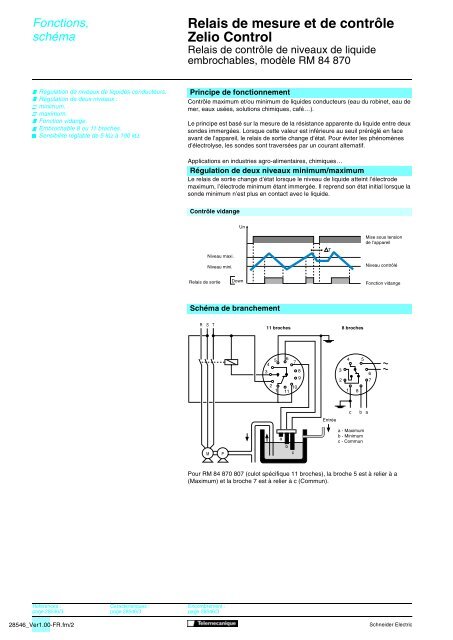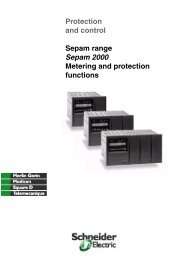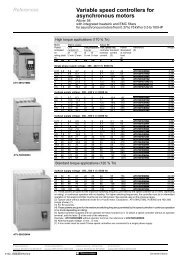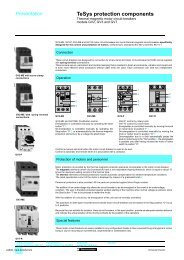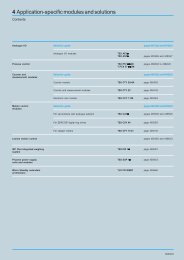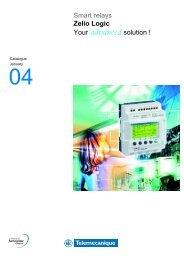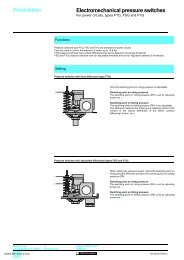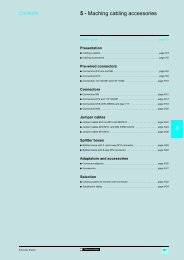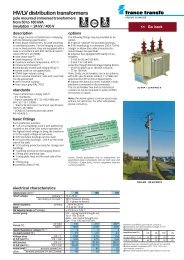Relais de mesure et de contrôle Zelio Control - Trinet
Relais de mesure et de contrôle Zelio Control - Trinet
Relais de mesure et de contrôle Zelio Control - Trinet
You also want an ePaper? Increase the reach of your titles
YUMPU automatically turns print PDFs into web optimized ePapers that Google loves.
Fonctions,<br />
schéma<br />
<strong>Relais</strong> <strong>de</strong> <strong>mesure</strong> <strong>et</strong> <strong>de</strong> contrôle<br />
<strong>Zelio</strong> <strong>Control</strong> 0<br />
<strong>Relais</strong> <strong>de</strong> contrôle <strong>de</strong> niveaux <strong>de</strong> liqui<strong>de</strong><br />
embrochables, modèle RM 84 870<br />
# Régulation <strong>de</strong> niveaux <strong>de</strong> liqui<strong>de</strong>s conducteurs.<br />
# Régulation <strong>de</strong> <strong>de</strong>ux niveaux :<br />
5 minimum,<br />
5 maximum.<br />
# Fonction vidange.<br />
# Embrochable 8 ou 11 broches.<br />
# Sensibilité réglable <strong>de</strong> 5 kΩ à 100 kΩ.<br />
Principe <strong>de</strong> fonctionnement<br />
Contrôle maximum <strong>et</strong>/ou minimum <strong>de</strong> liqui<strong>de</strong>s conducteurs (eau du robin<strong>et</strong>, eau <strong>de</strong><br />
mer, eaux usées, solutions chimiques, café…).<br />
Le principe est basé sur la <strong>mesure</strong> <strong>de</strong> la résistance apparente du liqui<strong>de</strong> entre <strong>de</strong>ux<br />
son<strong>de</strong>s immergées. Lorsque c<strong>et</strong>te valeur est inférieure au seuil préréglé en face<br />
avant <strong>de</strong> l’appareil, le relais <strong>de</strong> sortie change d’état. Pour éviter les phénomènes<br />
d’électrolyse, les son<strong>de</strong>s sont traversées par un courant alternatif.<br />
Applications en industries agro-alimentaires, chimiques…<br />
Régulation <strong>de</strong> <strong>de</strong>ux niveaux minimum/maximum<br />
Le relais <strong>de</strong> sortie change d’état lorsque le niveau <strong>de</strong> liqui<strong>de</strong> atteint l’électro<strong>de</strong><br />
maximum, l’électro<strong>de</strong> minimum étant immergée. Il reprend son état initial lorsque la<br />
son<strong>de</strong> minimum n’est plus en contact avec le liqui<strong>de</strong>.<br />
Contrôle vidange<br />
Un<br />
Niveau maxi.<br />
Niveau mini.<br />
T<br />
Mise sous tension<br />
<strong>de</strong> l’appareil<br />
Niveau contrôlé<br />
<strong>Relais</strong> <strong>de</strong> sortie<br />
Down<br />
Fonction vidange<br />
Schéma <strong>de</strong> branchement<br />
R S T<br />
11 broches<br />
8 broches<br />
4 5<br />
34 5 6 7<br />
8<br />
3<br />
9<br />
2<br />
2 10<br />
1 11 1<br />
8<br />
6<br />
7<br />
Entrée<br />
c b a<br />
M<br />
P<br />
a<br />
b<br />
c<br />
a - Maximum<br />
b - Minimum<br />
c - Commun<br />
Pour RM 84 870 807 (culot spécifique 11 broches), la broche 5 est à relier à a<br />
(Maximum) <strong>et</strong> la broche 7 est à relier à c (Commun).<br />
Références :<br />
page 28546/3<br />
28546_Ver1.00-FR.fm/2<br />
Caractéristiques :<br />
page 28546/3<br />
Encombrement :<br />
page 28546/3<br />
Schnei<strong>de</strong>r Electric


